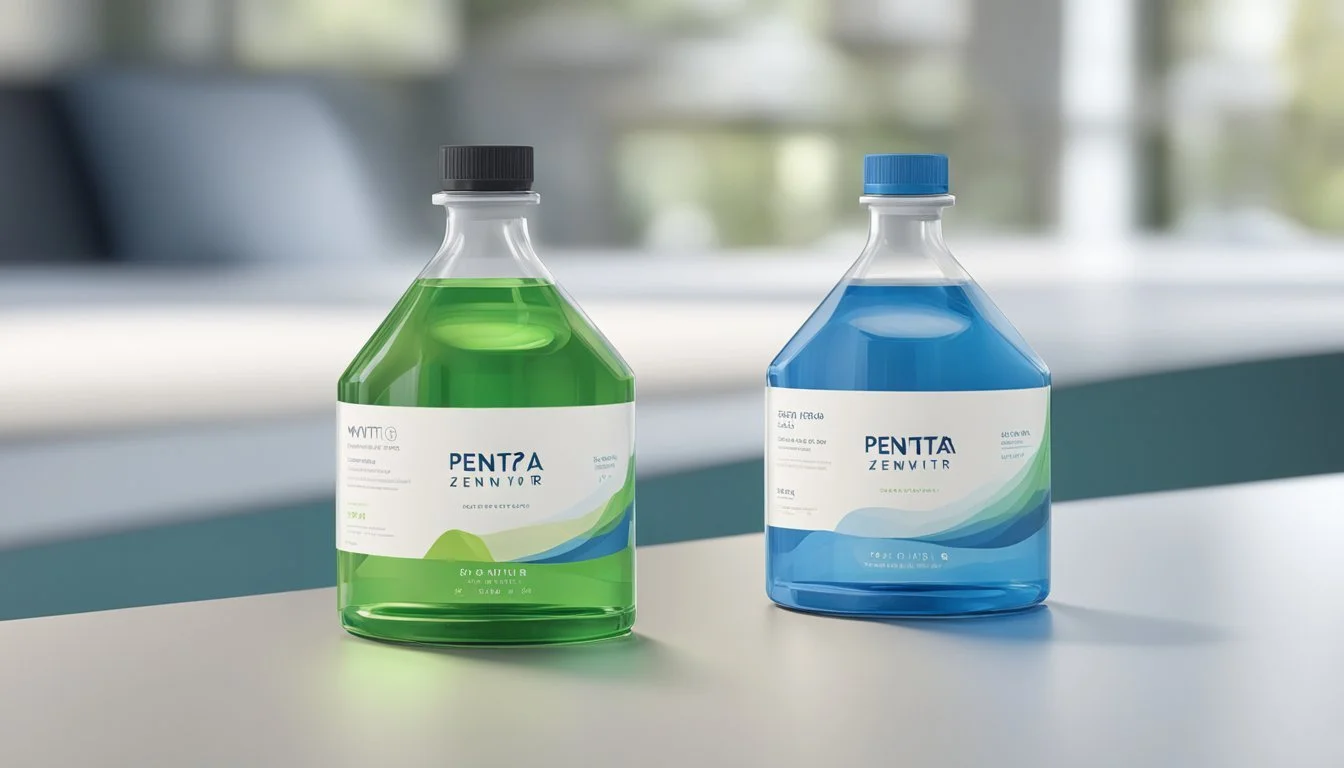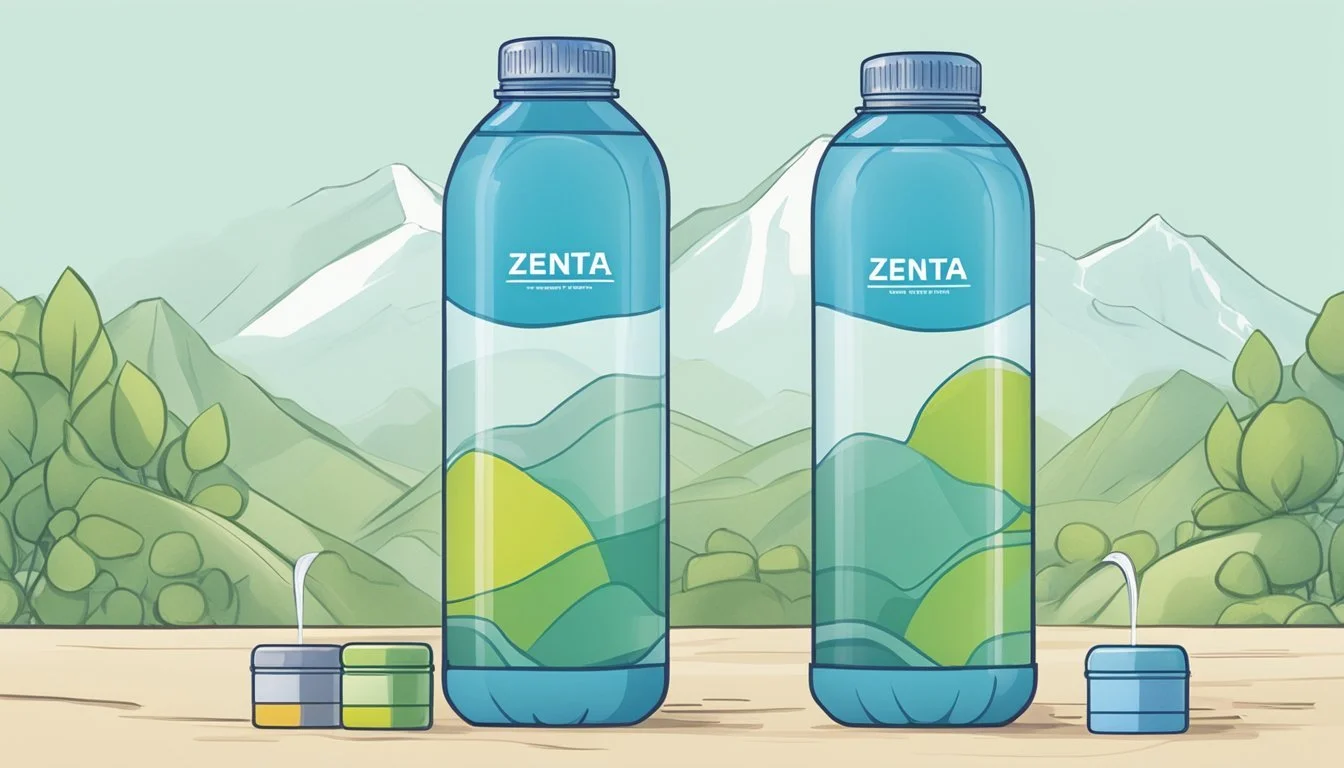Penta vs. Zenwtr
Which Bottled Water is Better Based on Quality and Taste?
Choosing between Penta and ZenWTR bottled waters can be a challenge, especially with both brands boasting unique benefits. Penta prides itself on its ultra-purified water, processed without additives, and claims to offer unparalleled purity and hydration. On the other hand, ZenWTR stands out with its natural alkalinity, featuring a 9.5 pH level, and emphasizes its eco-conscious packaging made from 100% recycled ocean-bound plastic.
When it comes to hydration and sustainability, ZenWTR's natural alkalinity and eco-friendly packaging give it an edge over Penta. While Penta provides exceptional purity and taste through its 13-step purification process, ZenWTR ensures that consumers not only stay hydrated but also contribute positively to environmental efforts.
Despite their differences, both Penta and ZenWTR cater to health-conscious individuals looking for quality bottled water. Whether you prioritize purity or environmental impact, understanding the distinct features of each brand can help you make an informed decision tailored to your lifestyle and values.
Understanding Bottled Water: Basics and Beyond
Selecting the right bottled water involves understanding various aspects such as the definition, pH significance, mineral content, and the importance of electrolytes. Each factor plays a crucial role in hydration and overall health.
Defining Bottled Water
Bottled water is water that is packaged in bottles for individual consumption. It comes from various sources like springs, wells, or even municipal supplies. The water undergoes different purification processes, including reverse osmosis and distillation, to ensure safety and improve taste.
Bottled water can be categorized as spring water, mineral water, and purified water, each having distinct properties and benefits. Spring water comes from natural springs, while mineral water contains dissolved minerals. Purified water undergoes rigorous filtering processes.
The Significance Of PH In Bottled Water
The pH level of bottled water, which measures its acidity, plays a significant role in determining its health benefits. pH levels can range from acidic (below 7) to alkaline (above 7). Most bottled waters strive to maintain a neutral or slightly alkaline pH.
For example, ZenWTR boasts a pH of 9.5, making it alkaline. This alkaline nature is believed to neutralize acid in the body, potentially boosting metabolism and improving hydration. On the other hand, some bottled waters are kept neutral to mimic the body’s natural balance.
Minerals And Their Roles In Hydration
Minerals present in bottled water are essential for optimal hydration. Calcium, magnesium, and potassium are common minerals found in mineral and spring waters. These minerals aid in bodily functions such as bone health, muscle function, and electrolyte balance.
Mineral content varies among brands, with some like Penta focusing on purity and minimalism, offering fewer minerals but high quality. Trace minerals can also impact the taste and health benefits of the water, making it crucial to choose a brand that matches one’s dietary needs.
Electrolytes: Essential for Balanced Hydration
Electrolytes are ions that help maintain fluid balance and muscle function. Common electrolytes include sodium, potassium, and magnesium. They facilitate nerve signals and hydration, making them vital for active individuals.
Bottled waters like ZenWTR and Penta may include added electrolytes or naturally occurring ones from sources. These electrolytes help replenish what’s lost during activities like exercise, promoting faster recovery and sustained hydration. When choosing bottled water, considering electrolyte content is essential for balanced, effective hydration.
Brand Profiles: Penta and Zenwtr
Penta and ZenWTR are both popular in the bottled water market, offering distinct features that cater to different consumer preferences. Penta is known for its pure hydration, while ZenWTR emphasizes its sustainability and alkaline properties. Below, let's explore the unique attributes of each brand and the vision behind ZenWTR's founder, Lance Collins.
Penta: Pure Hydration
Penta prides itself on providing ultra-pure bottled water. The brand's production process involves a 13-step purification method, ensuring an exceptionally clean and smooth taste. Penta water is free from additives, impurities, and contaminants, making it ideal for health-conscious consumers.
The company markets its product as being free of trace minerals, fluoride, chlorine, and BPA, aligning with their mission to offer pure hydration. Penta's minimalist approach is a stark contrast to other brands that incorporate various minerals and additives.
Zenwtr: Alkaline Hydration
ZenWTR offers ultra-pure vapor distilled alkaline water, packaged uniquely in bottles made from 100% recycled, certified ocean-bound plastic. This sustainable approach highlights the company’s commitment to reducing plastic waste and promoting environmental responsibility.
The water itself is alkaline, which many believe helps in balancing the body's pH levels. ZenWTR is available in various bottle sizes, including 1 Liter, 23.7 oz., and 16.9 oz., making it accessible for different consumer needs and preferences.
Founder's Vision: Understanding Lance Collins
Lance Collins, the founder of ZenWTR, is a well-known beverage entrepreneur who has successfully launched several popular brands. His vision for ZenWTR is centered around sustainability and premium quality. By using ocean-bound plastic for the bottles, Collins aims to make an environmental impact.
Collins’s commitment to creating innovative beverage solutions is evident in ZenWTR’s product offerings, combining health benefits with eco-conscious packaging. His influence and experience in the beverage industry have positioned ZenWTR as a forward-thinking brand.
Sustainability and Environmental Impact
Penta and ZenWTR have distinct approaches to sustainability and environmental impact. While both focus on reducing plastic waste and promoting eco-friendly practices, their methods and achievements vary.
The Importance of Ocean Conservation
Ocean conservation is vital in combatting plastic pollution. ZenWTR emphasizes their dedication to saving oceans by using certified ocean-bound plastic in their bottles. This plastic is collected from areas close to waterways before it can reach the ocean.
Penta’s efforts, although more focused on water purity, also aim to reduce environmental impact. Their bottles are made from BPA-free plastic. However, Penta does not highlight ocean conservation to the same extent as ZenWTR.
Recyclable Packaging Innovations
ZenWTR utilizes 100% post-consumer recycled bottles, derived from ocean-bound plastic. This sustainable solution not only helps in reducing waste but also encourages more recycling. The recycled plastic bottles set a standard for environmentally friendly packaging.
Penta also uses recyclable materials, focusing on BPA-free plastic. While they ensure safety and purity, their emphasis on sustainable packaging isn’t as prominent as ZenWTR’s. ZenWTR’s innovative use of ocean-bound plastic distinguishes them in this area.
Certified Ocean-Bound Plastic and Its Benefits
ZenWTR’s use of certified ocean-bound plastic significantly contributes to reducing plastic waste. This certification guarantees that the plastic is retrieved before it enters the ocean, providing a practical and impactful solution to ocean pollution.
The benefits include reducing plastic negative impact on marine life and promoting a circular economy. ZenWTR's commitment to certified ocean-bound plastic not only aids the environment but also provides consumers with a more sustainable choice.
In contrast, Penta focuses primarily on product purity rather than on the specific certification of plastic used. Although Penta’s BPA-free bottles are a safe alternative, ZenWTR’s certified ocean-bound plastic offers additional environmental benefits.
Water Sources and Purification Processes
When choosing between Penta and ZenWTR, understanding the water sources and purification methods is crucial. These factors impact the water's quality, taste, and health benefits.
Spring Water vs. Purified Water
Penta focuses on purified water, while some brands spotlight natural sources like mountain spring water. Spring water comes from natural underground sources and is often rich in minerals, which contribute to its taste and potential health benefits. Arrowhead Mountain Spring Water, for example, is sourced from protected springs, ensuring its natural composition remains intact.
On the other hand, purified water like Penta is typically sourced from tap water or groundwater and undergoes rigorous purification methods to remove impurities. This ensures a high-quality, contaminant-free beverage. Purified water tends to have a neutral taste and lacks the natural minerals found in spring water.
Reverse Osmosis and Distillation
Reverse osmosis (RO) is a popular purification process used by brands like Dasani and Penta. This method forces water through a semi-permeable membrane, filtering out a wide range of contaminants and minerals. The result is a clean, crisp taste and high-quality water with balanced purity.
Distillation is another common method. It involves boiling water and condensing the steam back into liquid form, removing impurities and contaminants in the process. Distilled water, while extremely pure, may lack some natural minerals, which can affect its taste. Penta utilizes Hydro-7, an advanced seven-step purification process that includes reverse osmosis, ensuring high standards of purity.
Vapor Distillation Method
ZenWTR employs an innovative vapor distillation method to produce its vapor-distilled alkaline water. This process heats water until it becomes vapor, separating it from contaminants and then condensing it back into a liquid. ZenWTR then adds electrolytes to enhance flavor and benefits.
The vapor distillation method involves multiple steps, such as UV treatments and ionization, to ensure optimal purity. This method results in water that is not only free from impurities but also boasts a high pH level, making it alkaline. This purification process helps ZenWTR maintain a reputation for producing premium, high-quality bottled water free from unwanted flavors and contaminants.
Taste and Water Quality
Both Penta and ZenWTR are popular bottled waters known for their high quality and distinctive taste. This section aims to explore the role of pH levels in taste and the factors contributing to the purity and contaminant levels in both brands.
The Role of pH Levels in Taste
Penta and ZenWTR have different pH levels that influence their taste profiles. ZenWTR boasts a pH of 9.5, making it alkaline. Alkaline water typically has a smoother, slightly sweeter taste compared to neutral or acidic water. This can make ZenWTR appealing to those who prefer a less acidic aftertaste.
Penta, on the other hand, has a neutral pH of around 7. This neutrality contributes to a clean, crisp taste without any noticeable tang or flavor. For consumers seeking a pure, unaltered water experience, Penta provides a straightforward hydration option without the altering effects of higher alkalinity.
Identifying Contaminants and Purity
Penta and ZenWTR undergo rigorous filtration processes to ensure the highest purity levels. Penta emphasizes its 13-step purification process, which includes reverse osmosis and ultraviolet treatment. This meticulous process aims to remove any potential contaminants, ensuring that the water is as pure as possible.
ZenWTR, while also subjected to thorough filtration, gains an additional layer of purity from its natural alkalinity. The water's high pH level may contribute to the neutralization of certain contaminants. Both brands comply with EPA regulations for water quality, regularly testing for heavy metals and other harmful substances.
The materials used in packaging are another critical aspect. Penta and ZenWTR employ BPA-free bottles to further safeguard against contamination, maintaining the water's purity from source to consumer.
Economic Landscape and Market Analysis
Analyzing the current economic landscape provides insights into how bottled water brands like Penta and ZenWTR operate, compete, and carve out their market shares. This section explores market dynamics and what it takes for a beverage brand to become a leader in the industry.
Beverage Brands and Market Share
The bottled water market in the U.S. is vast, with major players such as Aquafina, Dasani, Deer Park, Fiji, Evian, and Poland Spring dominating shelves. The market size was estimated at $44.6 billion in 2023, showcasing significant growth potential. Brands like ZenWTR and Penta strive to capture a slice of this market by differentiating through unique selling points such as sustainability and mineral content.
ZenWTR, for instance, emphasizes its use of 100% post-consumer recycled bottles made from ocean-bound plastic. This appeals to environmentally conscious consumers and positions ZenWTR favorably against brands like Essentia and Smartwater, which focus on premium and functional benefits. In contrast, Penta appeals to health-conscious consumers with its ultra-purified water, highlighting its rigorous purification process that strips away contaminants and impurities.
The Path to Becoming a Beverage Leader
Becoming a key player in the beverage business requires not only a unique value proposition but also strong marketing, distribution networks, and consumer trust. ZenWTR leverages its founder Lance Collins' background—also known for launching the Nos energy drink and Bodyarmor sports drink—to build credibility. Mentions in major retailers like Whole Foods Market and partnerships with other eco-friendly brands further boost visibility and consumer trust.
For Penta, rigorous water purification processes coupled with strategic distribution partnerships ensure wide availability. Competing with giants like Coca-Cola's Dasani and PepsiCo’s Aquafina is no small feat, requiring innovative marketing and substantial capital investment. Both Penta and ZenWTR's strategies focus on carving niches in a highly competitive market filled with both established names and emerging brands.
In conclusion, understanding the economic landscape and the competitive framework allows us to see how brands like Penta and ZenWTR navigate the complex, high-stakes world of bottled water.
Consumer Guidance: Choosing the Right Water
Selecting the perfect bottled water involves considering factors like price and access to premium water options. Here, we explore these aspects to help you make the best decision.
Price Considerations and Value
When assessing bottled water options, price is a significant factor. Penta Water generally positions itself at the higher end of the market due to its multi-step purification process and ultra-pure nature. On the other hand, ZenWTR is priced competitively, offering alkaline water with a pH of 9.5.
For budget-conscious consumers, purchasing in bulk from retailers like Whole Foods Market might offer better value. Comparing per-liter costs can also highlight significant savings over time. Lists and charts can aid in understanding price differences, showcasing price per liter and potential savings for bulk purchases.
How to Access and Subscribe to Premium Waters
Accessing premium bottled water like Penta and ZenWTR can be straightforward through several channels. Many consumers opt to purchase through Whole Foods Market, which stocks a variety of premium water brands. Subscription services offer convenience, allowing regular deliveries to your home or office.
ZenWTR offers direct subscriptions through their website, providing discounts for recurring orders. Penta Water can sometimes be harder to find, but specialty online stores and certain retailers carry it. Subscribing ensures uninterrupted access and often comes with perks like discounts and exclusive offers, making high-quality hydration both easy and economically viable.
Community and Environmental Advocacy
Penta and ZenWTR are deeply invested in community and environmental causes, focusing on partnerships with ocean organizations, recycling education, and support for at-risk coastal environments.
Partnerships with Ocean Organizations
Penta and ZenWTR actively collaborate with nonprofits dedicated to ocean conservation. ZenWTR partners with organizations to remove plastic from the ocean. They claim every bottle sold eliminates five plastic bottles from the ocean. Their work aids in the fight against ocean pollution, promoting cleaner and safer marine ecosystems.
Penta also partners with various environmental groups. Their focus is on reducing the impact of plastic water bottles and supporting initiatives that aim to restore and protect ocean habitats. These partnerships are key to their environmental advocacy efforts, demonstrating a strong commitment to ocean health.
Education Initiatives for Recycling
ZenWTR emphasizes recycling education to encourage responsible consumer behavior. They run campaigns to educate the public on proper recycling practices and the environmental impacts of plastic waste. This helps elevate awareness and action toward reducing plastic pollution.
Penta also contributes to recycling education. Their efforts include school programs that teach children about the importance of recycling and its role in ocean conservation. By fostering early awareness, Penta aims to build a more environmentally conscious future generation.
Support for At-Risk Coastal Environments
Both companies take significant steps to support at-risk coastal environments. ZenWTR allocates funds from their sales to projects that clean beaches and protect marine life across various coastal regions. Their focus on mitigating ocean pollution helps preserve these fragile ecosystems.
Penta shows commitment through financial support and participation in coastal cleanup events. They prioritize regions heavily impacted by plastic pollution, enhancing the resilience of these environments. Their hands-on approach includes collaboration with local communities to implement long-term conservation strategies.
In summary, Penta and ZenWTR's community and environmental advocacy are essential components of their brand. Through strategic partnerships, educational initiatives, and support for vulnerable coastal areas, they demonstrate a proactive stance in battling ocean pollution and promoting sustainability.
More About Penta
Mountain Valley Spring Water vs Penta: Which Bottled Water is Better?
Penta vs Richard's Rainwater: Which Bottled Water is Better?
Penta vs Whole Foods Italian Still Mineral water: Which Bottled Water is Better?






